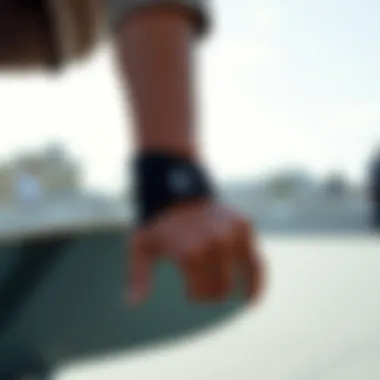Top Wrist Braces for Skateboarding: A Comprehensive Guide


Intro
Skateboarding, an exhilarating dance on wheels, calls for a keen sense of balance and quick reflexes. However, with every flip and grind comes the risk of injury, particularly to the wrists, which are often the first to bear the brunt of falls. That’s where wrist braces enter the scene, becoming not just a safety measure but a crucial part of a skater's gear. They can significantly diminish the chance of injuries while amplifying performance. In this article, we will explore various wrist braces designed specifically for skateboarders, highlight their importance in injury prevention, and assess how they can play a pivotal role in enhancing skating skills.
Understanding the mechanics behind wrist injuries will guide skaters to make informed choices when selecting the right brace. Individual skating styles and needs vary widely, so we aim to dissect the choices available on the market. We will also gather insights from real-world user experiences, giving you a comprehensive understanding of the best options out there.
This journey will serve as an essential resource for skaters—whether you are just kicking off your board or looking to nail that next trick—allowing you to protect your wrists while enjoying the sport you love. Let's delve into the techniques, skills, and culture that surround skateboarding, leading us to the best wrist braces suited for this colorful activity.
Prolusion
Wrist protection is a crucial consideration for skateboarders. Whether you're just carving through the park or tackling complex tricks, your wrists take on substantial impact. A well-chosen wrist brace can be a game changer, not only in shielding you from injuries but also in enhancing your performance. In this article, we shall explore the depths of wrist braces tailored for skateboarding, focusing on factors like injury prevention and comfort.
Among the myriad of risks associated with skateboarding, wrist injuries are notably prevalent. They stem from falls, collisions, or improper landings. For skaters, understanding the mechanics of these injuries can illuminate the necessity of using wrist protection. Ultimately, knowing how to choose the right brace can maximize your skating experience while minimizing potential risks.
The Importance of Wrist Protection in Skateboarding
To understand why wrist protection is essential, consider the mechanics of skateboarding. The wrists are often the first point of contact when a skater falls. An untreated injury can lead to chronic pain or long-term disability, which can cut back on your skateboarding enjoyment. A secure wrist brace works to stabilize your joints, reducing the chance of sprains or fractures. Additionally, proper support can help maintain optimal wrist alignment, allowing you to focus on your tricks rather than worrying about injury.
Furthermore, wearing a brace can instill a sense of confidence in your skating. Knowing that your wrists are protected can encourage skaters to push their limits, trying new tricks or increasing their airtime. This psychological edge is just as vital as the physical benefits, creating a holistic safety net for the skater.
Overview of Wrist Injuries in Skaters
Wrist injuries among skaters can occur in a variety of ways. Understanding these injuries is key to recognizing the value of a good wrist brace. The most common wrist injuries include:
- Sprains: These happen when ligaments are stretched beyond their normal capacity, often occurring during sudden falls.
- Fractures: The impact from a fall can lead to wrist fractures, which could range from mild to severe and may require medical intervention.
- Tendinitis: Repetitive motions, often involved in skating, can lead to inflammation in the tendons, resulting in chronic pain.
Each type of injury can impact your ability to skate and may sideline you for weeks or even months. Therefore, employing wrist protection is not merely a suggestion; it is a necessity for long-term skating enjoyment.
In the following sections, we will delve deeper into the anatomy of the wrist, explore the different types of wrist braces available, and provide insights into choosing the right one for your individual needs.
Anatomy of the Wrist
Understanding the anatomy of the wrist is crucial for any skateboarder looking to prevent injuries and enhance performance. The wrist is a complex structure made up of several bones, ligaments, and tendons that provide both flexibility and stability. When skating, the wrist bears a significant portion of the impact during falls and tricks, making it susceptible to injuries. Having a solid grasp of how the wrist functions can better inform decisions when it comes to choosing appropriate protective gear, particularly wrist braces.
Components of the Wrist
The human wrist consists of eight small bones known as carpal bones, which are grouped into two rows:
- Proximal Row: Scaphoid, Lunate, Triquetrum, and Pisiform.
- Distal Row: Trapezium, Trapezoid, Capitate, and Hamate.
These bones connect to the radius and ulna, the two long bones of the forearm. Together, they create a versatile joint; this allows for a vast range of motion, enabling skateboarders to flex, extend, and rotate effortlessly.
Ligaments connect the bones, while tendons link muscles to the bones, allowing for movement. The flexor tendons enable wrist flexion, while the extensors facilitate wrist extension. Importantly, this interplay between the bones and soft tissues is what gives skateboarders the mobility needed to perform tricks or land after jumps. However, this also leaves room for strains and sprains, especially when landing might not go as planned.
Common Wrist Injuries Among Skaters


Skateboarding is thrilling, but it can lead to various wrist injuries, especially for beginners or during challenging tricks. Some common injuries include:
- Sprains: These happen when the ligaments are stretched or torn, often resulting from falls.
- Fractures: Wrist fractures, particularly of the scaphoid bone, can occur during a hard impact, often when a skater tries to catch themselves with their hands during a fall.
- Tendinitis: Overuse can lead to inflammation of tendons, especially in seasoned skaters who push the limits of their wrist mobility.
Injuries can sideline a skater for weeks or even months. Having a strong understanding of the wrist’s anatomy and the common injuries associated with skating is essential for effective prevention strategies.
Protecting the wrist through proper gear and potentially a good wrist brace can drastically reduce the risk of these injuries. By knowing how the wrist is structured and the stress it endures, one can make informed decisions about care and prevention.
Types of Wrist Braces
When it comes to skateboarding, protecting your wrists is a must. The right wrist brace can make all the difference in both preventing injuries and ensuring optimum performance on the board. Understanding the different types of wrist braces available is crucial to determine which one suits your skating style and needs. In this section, we will dissect the various types of wrist braces commonly used by skaters, highlighting their specific benefits and considerations.
Supportive Braces
Supportive braces offer a balanced approach between flexibility and stability. They are designed to provide moderate support while allowing a decent range of motion. These braces are typically made from soft materials like neoprene or fabric and often include adjustable straps for a snug fit.
- Benefits:
- Considerations:
- Offers protection against minor sprains and strains.
- Allows for greater wrist mobility, which is essential for performing tricks.
- Comfortable enough for extended wear.
- Not suitable for severe injuries or high-impact falls.
- Might wear down faster than more rigid options if used extensively in high-intensity situations.
Supportive braces could be ideal for those who want a little extra cushion for the push, especially when engaging in new tricks or skating for longer sessions without feeling rigidity.
Rigid Braces
On the other hand, rigid braces are crafted from stiffer materials like plastic or fiberglass. They provide a higher level of support, rendering the wrist nearly immobile. This type of brace is perfect for anyone recovering from a serious injury or for skaters who want to take preventative measures against severe damage.
- Benefits:
- Considerations:
- Extremely effective in stabilizing the wrist during high-impact activities.
- Reduces the risk of re-injury post-recovery.
- Ideal for skaters who may be prone to more severe injuries due to aggressive skating styles.
- Limited range of motion can be a challenge during trick execution.
- Discomfort may arise from prolonged use.
Rigid braces can be a lifesaver for someone who’s been down that road before and doesn't want to take any chances again. However, it’s also important to note that while they provide strong support, they can feel cumbersome for some. Finding a balance is key.
Kinesiology Tape vs. Braces
Now, let’s compare kinesiology tape with traditional wrist braces. Kinesiology tape is a flexible, elastic cotton strip that can be applied to the skin to support muscles and joints without restricting movement.
- Benefits of Kinesiology Tape:
- Limitations:
- Promotes better blood circulation, which can aid healing.
- Allows for full mobility while offering support.
- Typically easier to carry around and apply.
- May not provide as much support as a solid brace for severe issues.
- Lifespan is limited; tape can peel off, especially if exposed to sweat or water.
In contrast to standard wrist braces, kinesiology tape offers a more dynamic solution allowing for a wider range of motion, making it appealing for many skaters.


"The choice between tape and a brace truly boils down to injury status and personal preference. What feels right for one skater may not for another."
Choosing the appropriate wrist support is personal, and understanding these options can help you feel more confident in your skating journey. Whether you opt for a supportive brace, a rigid brace, or take a chance on kinesiology tape, always consider what works best for your skating style, needs, and comfort.
Choosing the Right Wrist Brace
Selecting the right wrist brace plays a pivotal role in ensuring both safety and performance for skateboarders. In a sport known for its high impact and potential for falls, wrist protection isn't just an accessory; it's essential gear. A suitable wrist brace can be the difference between a smooth ride and a painful session.
When it comes to choosing a wrist brace, thorough consideration of key elements is fundamental. Factors such as the level of support, the material's comfort, and how well the brace adjusts to your wrist size can significantly affect how effective the brace is.
Factors to Consider
Level of Support
The level of support is paramount when selecting a wrist brace. A well-supported wrist can prevent hyperextension, sprains, and fractures that are common in skateboarding. High-quality braces often feature rigid components that provide substantial stabilizing force.
A brace with ample support can be a beneficial choice because it allows skaters to focus on their tricks rather than worrying about wrist stability.
- Unique Feature: Many supportive braces now incorporate ergonomic designs that align with the wrist's natural movement, making them less cumbersome. This not only aids in trick performance but also alleviates fatigue during long skate sessions.
- Advantages: Enhanced protection greatly minimizes the risk of injuries. However, it's essential to strike a balance; too rigid a support may hinder movement and precision needed for advanced skating tricks.
Material and Comfort
Material and comfort are just as important. A wrist brace made from breathable yet durable materials can increase usage comfort, allowing skaters to wear their braces for extended periods without discomfort.
The use of lightweight materials enhances the sensation of freedom on the board.
- Key Characteristic: Most modern wrist braces utilize synthetic fabrics, which wick moisture and provide flexibility. The beneficial choice lies in their durability without the added bulk.
- Unique Feature: Look for braces that feature removable or adjustable padding. This can help ensure a snug yet comfortable fit.
- Disadvantages: Keep an eye out for braces that might not provide enough ventilation, leading to sweat buildup.
Adjustability and Fit
Finally, adjustability and fit are critical to maximizing the wrist brace's effectiveness. Proper fit ensures that the brace stays in place during tricks and doesn't hinder mobility.
Skaters may have varying wrist sizes due to their individual build, so braces with adjustable straps or closure systems can cater to a wide array of users.
- Key Characteristic: Many products now come equipped with Velcro straps or modular design which allows a custom fit.
- Unique Feature: An adjustable brace ensures that as your skating style evolves or if you develop an injury, you can adapt your brace to support just what you need to ensure proper protection.
- Advantages: Achieving the right fit can enhance performance, but it’s important to check that the brace doesn’t compress the wrist excessively, which can lead to circulation issues.
Identifying Your Skating Style
Identifying your skating style is crucial in narrowing down your choices for a wrist brace. Skaters who focus on ramps may have different brace needs compared to those who pursue street skating. The combination of style and the right protective gear can effectively enhance overall performance while diminishing the risk of injury.
Popular Wrist Braces for Skateboarding
When it comes to skateboarding, wrist safety can't be an afterthought. The right wrist brace can be the difference between nailing that trick and spending a month nursing a painful sprain. With skateboarding's fast-paced nature, having reliable gear like a quality wrist brace is crucial. It not only supports your wrist during falls but also potentially prevents those nagging injuries that could keep you off your board for weeks.
Review of Top Models
Material Quality and Design


Understanding the material quality and design of wrist braces is vital for any skater looking to protect their wrists. High-end braces often utilize materials that offer a balance of strength and flexibility. For instance, braces made from a blend of neoprene and nylon tend to provide durable support while allowing some degree of movement. This is especially important for skateboarders who require both stability and range of motion.
A standout in this category is the Evil Skate Wrist Brace. Its unique tri-layer design combines a breathable fabric with a reinforced exterior. Skaters appreciate this because it keeps the wrist snug while preventing overheating during those long sessions at the park. However, skaters should note that while a robust design can stave off injury, it may feel a little bulky to those used to skating without any wrist support.
"Choosing a brace that feels right during skating is just as important as its protective qualities."
User Feedback and Performance
User feedback is arguably the backbone of assessing performance for any product, and wrist braces are no different. Many skaters flock to forums and social media to share their experiences, making it easier for others to choose wisely. The ProTec Wrist Guard, for example, has garnered positive assessments for its effective shock absorption. Skaters repeatedly mention how it allows them to take hard falls without sustaining serious damage.
Moreover, the adjustable straps are often praised for accommodating different wrist sizes, a feature that many find beneficial. On the flip side, some users report that while it performs well, after prolonged usage, the padding can compress, leading to reduced effectiveness over time. This highlights the need for skaters to monitor wear and possibly consider having multiple braces in rotation, especially if they skate frequently.
In summary, choosing a wrist brace isn't just about picking any piece of gear off the shelf. It's about diving into the details—whether it be material quality or personal feedback from fellow skaters—that ensures your wrists stay in prime condition while you roll through life on your skateboard.
Maintaining Your Wrist Brace
Taking care of your wrist brace is just as essential as the choice you made when selecting it. A well-maintained brace not only provides the necessary support during your skate sessions but also enhances its lifespan, saving you money and ensuring you stay protected as you hit the skateboard. Regular care and attention can make a world of difference; it’s not merely about having the right gear but also about looking after it diligently.
Proper Care and Cleaning
Cleaning your wrist brace isn’t just about keeping it looking fresh; it’s vital for maintaining its functionality. After every session, even if you feel tired enough to just toss it aside, take a moment to wipe down the exterior with a damp cloth. This removes dirt and sweat that could break down the material over time.
- Hand Washing: Most braces can be hand-washed with mild soap. You don’t want to toss it in a washing machine because the agitation can damage the structure and support.
- Air Dry Only: Never put it in the dryer. Instead, let it air-dry completely before using it again. This helps in avoiding mold and bad smells, allowing it to stay functional longer.
- Disinfect Regularly: Use disinfectant sprays or wipes to keep bacteria at bay, especially if you skate often in sweaty or humid conditions.
These little steps ensure your brace remains a reliable companion on your skating journey, keeping your wrist safe from unexpected injuries.
When to Replace Your Brace
No one likes to think about replacing gear, especially when it’s performed well so far. However, knowing when to retire your wrist brace is crucial.
- Visible Wear and Tear: If you start noticing frayed edges or any cracks in the structure, it's time to consider a new one. A compromised brace can lead to inadequate support.
- Loss of Support: Braces aren’t meant to last indefinitely. If you feel that your brace no longer provides the support it used to, perhaps because it’s become too loose or lacks rigidity, do not hesitate to replace it.
- Persistent Pain or Discomfort: If you notice recurring pain in your wrist while using your brace, it could signal that it’s time to bid farewell to the old one. Ignoring this can lead to more serious injuries as you push through discomfort.
"A worn-out brace won't just fail to protect but can become a liability. Listen to your body and your equipment."
Maintaining your wrist brace isn’t just about routine cleaning; it’s about ensuring your safety and performance. The moments you take to care for it matter immensely. Skating can be unpredictable, but your wrist support shouldn’t be.
Culmination
In this comprehensive exploration of wrist braces tailored for skateboarding, the importance of selecting the right brace cannot be overstated. A well-fitting and supportive wrist brace can play a pivotal role in protecting skaters from injuries, which can derail their passion for skateboarding. The conclusions drawn from this article summarize critical considerations that skaters should weigh when looking for a wrist brace.
Summary of Key Considerations
- Fit and Comfort: A brace that fits well is crucial. Ensure that it doesn’t restrict movement too much and allows for some flexibility. Look for braces made with breathable materials to keep your wrist comfortable during long skating sessions.
- Level of Support: Skaters vary in style and need; thus, the level of support is paramount. A hybrid brace that allows for some wrist movement may work better for agile tricks, while a more rigid design might be better suited for those focusing on stability and injury prevention.
- Activity Level and Style: Consider your skating environment and style. Casual skaters may require different features than those performing high-impact tricks at skate parks.
Ultimately, understanding these key considerations can significantly inform a skater's choice in wrist braces and enhance their skating experience.
Final Thoughts on Wrist Health in Skateboarding
It is vital to remember that taking care of your wrists extends beyond just the use of braces. Regular strength exercises for the wrists can go a long way in enhancing overall wrist health. Skaters should also engage in stretching routines to maintain flexibility and reduce the risk of injuries.
As per experts on neurology and sports medicine, prevention is always better than cure. The right awareness about wrist protection not only enhances performance but can lead to longevity in skateboarding.
In summary, making a well-informed decision in selecting wrist protection gear is essential for every skateboarder eager to enhance their skills while minimizing risks. Therefore, invest time and effort into understanding what works best for your individual needs as you continue to ride and push your limits.







